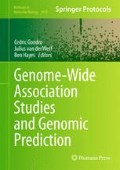Abstract
Genomic best linear unbiased prediction (gBLUP) is a method that utilizes genomic relationships to estimate the genetic merit of an individual. For this purpose, a genomic relationship matrix is used, estimated from DNA marker information. The matrix defines the covariance between individuals based on observed similarity at the genomic level, rather than on expected similarity based on pedigree, so that more accurate predictions of merit can be made. gBLUP has been used for the prediction of merit in livestock breeding, may also have some applications to the prediction of disease risk, and is also useful in the estimation of variance components and genomic heritabilities.
Access this chapter
Tax calculation will be finalised at checkout
Purchases are for personal use only
References
Yang J, Benyamin B, McEvoy BP et al (2010) Common SNPs explain a large proportion of the heritability for human height. Nat Genet 42:565–571
Meuwissen THE, Hayes BJ, Goddard ME (2001) Prediction of total genetic value using genome-wide dense marker maps. Genetics 157:1819–1829
Habier D, Tetens J, Seefried FR et al (2010) The impact of genetic relationship information on genomic breeding values in German Holstein cattle. Genet Sel Evol 42:5
Habier D, Fernando RL, Kizilkaya K et al (2010) Extension of the Bayesian alphabet for genomic selection. In: Proceedings of the ninth congress on genetics applied to livestock production, Leipzig, 1–6 Aug 2010
VanRaden PM, Van Tassell CP, Wiggans GR et al (2009) Invited review: reliability of genomic predictions for North American Holstein bulls. J Dairy Sci 92:16–24
Harris BL, Johnson DL, Spelman RJ (2008) Genomic selection in New Zealand and the implications for national genetic evaluation. In: Sattler JD (ed) Proceedings of the 36th ICAR session, Niagara Falls, New York, pp 325–330
Moser G, Tier B, Crump RE et al (2009) A comparison of five methods to predict genomic breeding values of dairy bulls from genome-wide SNP markers. Genet Sel Evol 41:56
Habier D, Fernando RL, Dekkers JCM (2007) The impact of genetic relationship information on genome-assisted breeding values. Genetics 177:2389–2397
Clark S, Hickey JM, van der Werf JHJ (2011) Different models of genetic variation and their effect on genomic evaluation. Genet Sel Evol 43:18
VanRaden PM (2008) Efficient methods to compute genomic predictions. J Dairy Sci 91:4414–4423
Misztal I, Legarra A, Aguilar I (2009) Computing procedures for genetic evaluation including phenotypic, full pedigree, and genomic information. J Dairy Sci 92:4648–4655
Nejati-Javaremi A, Smith C, Gibson JP (1997) Effect of total allelic relationship on accuracy of evaluation and response to selection. J Anim Sci 75:1738–1745
Villanueva B, Pong-Wong R, Fernandez J et al (2005) Benefits from marker-assisted selection under an additive polygenic genetic model. J Anim Sci 83:1747–1752
Goddard ME, Hayes BJ, Meuwissen TH (2011) Using the genomic relationship matrix to predict the accuracy of genomic selection. J Anim Breed Genet. doi:10.1111/j.1439-0388.2011.00964.x
Visscher PM, Medland SE, Ferreira MA et al (2006) Assumption-free estimation of heritability from genome-wide identity-by-descent sharing between full siblings. PLoS Genet 2:e41
Hill WG, Weir BS (2011)Variation in actual relationship as a consequence of Mendelian sampling and linkage. Genet Res doi:10.1017/S0016672310000480. http://dx.doi.org/
Hayes BJ, Visscher PM, Goddard ME (2009) Increased accuracy of artificial selection by using the realized relationship matrix. Genet Res 91:47–60
Clark SA, Hickey JM, Daetwyler H et al (2012) The importance of information on relatives for the prediction of genomic breeding values and the implications for the makeup of reference data sets in livestock breeding schemes. Genet Sel Evol 44:4
Gilmour AR, Gogel BJ, Cullis BR et al (2009) ASReml user guide release 30. VSN International, Hemel Hempstead
Forni S, Aguilar I, Misztal I (2011) Different genomic relationship matrices for single-step analysis using phenotypic, pedigree and genomic information. Genet Sel Evol 43:1
Author information
Authors and Affiliations
Editor information
Editors and Affiliations
Rights and permissions
Copyright information
© 2013 Springer Science+Business Media, LLC
About this protocol
Cite this protocol
Clark, S.A., van der Werf, J. (2013). Genomic Best Linear Unbiased Prediction (gBLUP) for the Estimation of Genomic Breeding Values. In: Gondro, C., van der Werf, J., Hayes, B. (eds) Genome-Wide Association Studies and Genomic Prediction. Methods in Molecular Biology, vol 1019. Humana Press, Totowa, NJ. https://doi.org/10.1007/978-1-62703-447-0_13
Download citation
DOI: https://doi.org/10.1007/978-1-62703-447-0_13
Published:
Publisher Name: Humana Press, Totowa, NJ
Print ISBN: 978-1-62703-446-3
Online ISBN: 978-1-62703-447-0
eBook Packages: Springer Protocols

